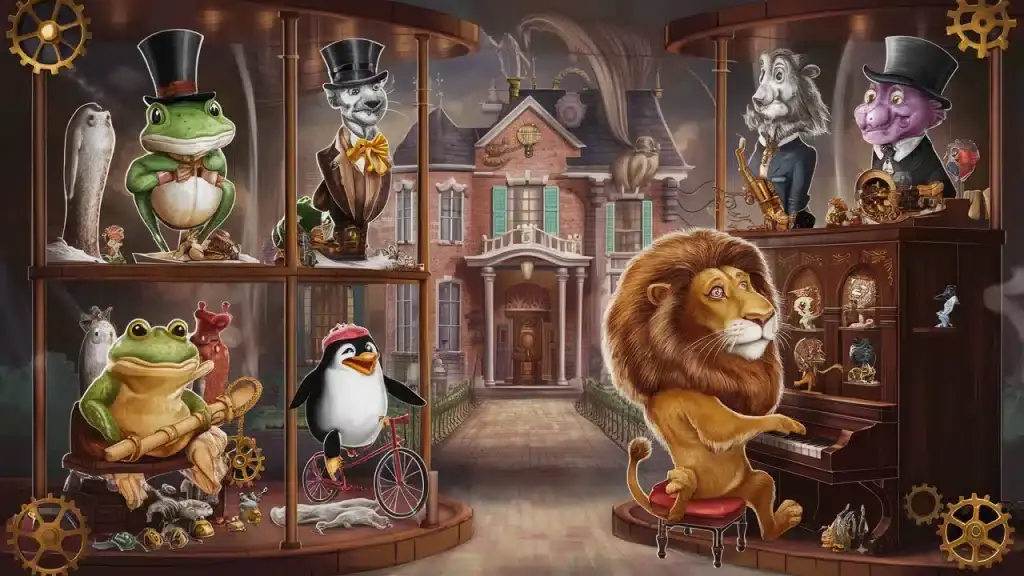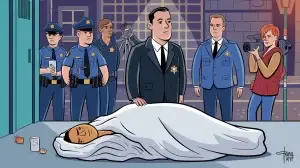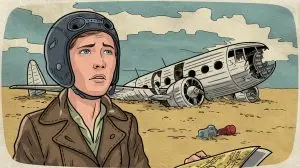Impossible Zoo Victorian Taxidermy Oddities. Imagine a time when stuffed animals weren’t just toys but intricate works of art. Welcome to the world of Impossible Zoo Victorian taxidermy oddities.
During the Victorian Era, people became fascinated with the natural world and whimsical fantasy, leading to the creation of unique taxidermy exhibits.
These displays often featured animals posed in human-like scenarios, blending science and imagination. This quirky trend even saw dead rodents becoming the darlings of the Victorian elite.

This unusual art form was more than just a hobby. It represented the era’s love for exploration and scientific curiosity.
Taxidermists, like Hermann Ploucquet, created elaborate scenes that captured the public’s imagination.
People flocked to museums to see these curious combinations of nature and creativity, making Victorian taxidermy a true spectacle of its time.
Queen Victoria’s reign saw many societal changes, and the rise of taxidermy was a part of this cultural shift.
From exotic birds to anthropomorphic rodents, these oddities were a staple in 19th-century Europe.
They not only provided a glimpse into the era’s scientific advancements but also reflected its playful spirit.
Dive into this extraordinary world and discover how Victorian taxidermy turned the impossible into a charming reality.
The Art of Victorian Taxidermy

Victorian taxidermy turned the preservation of animals into a fascinating blend of science and art. This unique craft involved lifelike mounting and intricate techniques to create stunning displays.
Historical Context
Victorian taxidermy became popular in the 19th century, particularly after the 1851 Great Exhibition in London.
This period saw a surge in interest in natural history and collecting exotic species.
Wealthy households showcased these specimens to display their knowledge and appreciation of nature.
In those times, taxidermy wasn’t just about preserving animals; it was about creating artistic representations.
Taxidermists like William Temple Hornaday became notable figures.
These artists combined their skills to produce astonishingly realistic pieces, even helping to establish institutions like the National Zoo.
Techniques and Materials
Victorian taxidermists used various materials and techniques to create lifelike displays.
Initially, they started with the literal stuffing of animal skins, packing them with hay or cotton.
For larger animals, they built frames using wire and metal cages.
Advancements introduced glass eyes and more sophisticated methods.
Preserving the skin involved tanning, and precise mounting was crucial.
Taxidermists often documented the species, origin, and details of their craft, adding an authentic touch to each piece.
Their work wasn’t just scientific; it was an art form. Every mounted animal was a testament to their skill and dedication in preserving nature’s beauty.
Iconic Taxidermists and Collections

Some Victorian taxidermists earned fame for their captivating displays. Walter Potter’s whimsical dioramas and Rowland Ward’s show-stopping exhibits at the Great Exhibition of 1851 are prime examples. These collections amazed onlookers and continue to fascinate enthusiasts today.
Walter Potter’s Enchanting Dioramas
Walter Potter, born in 1835 in Bramber, England, enchanted Victorians with his quirky dioramas.
He wasn’t just putting animals on display—he created entire tiny worlds. Think kittens having tea parties and frogs playing leapfrog.
His most famous work, “The Death and Burial of Cock Robin,” included over 98 animals in a detailed, storytelling scene.
Potter’s creations were not only whimsical but also incredibly detailed. Each animal was dressed in custom-made clothing and arranged in scenes that mirrored human society.
These dioramas drew thousands of visitors to his museum until it was controversially auctioned off in 2003.
Despite the dispersal of his collection, Potter remains a beloved figure in the world of taxidermy.
Rowland Ward and the Great Exhibition of 1851
Rowland Ward, another towering figure in Victorian taxidermy, made his mark at the Great Exhibition of 1851.
The event was a showcase of the age’s technological advancements and artistic achievements.
Ward’s specimens were a highlight, featuring meticulously preserved exotic animals that wowed the crowds.
Ward was more than just a taxidermist; he was a master craftsman who blended science and art.
His displays included everything from African big game to exotic birds, all arranged in lifelike poses.
People flocked to see his work, and he gained a reputation for setting high standards in the field. Even today, collectors and historians regard Ward’s contributions as groundbreaking.
Cultural Significance and Science

Victorian taxidermy wasn’t just for display; it played crucial roles in society and scientific study. From social status to understanding the natural world, it had a significant impact.
Taxidermy in Victorian Society
In Victorian society, taxidermy was more than a hobby—it was a status symbol.
Wealthy individuals showcased exotic animals like tigers or leopards to highlight their social standing.
Even pubs displayed fish taxidermy to create a unique atmosphere, especially in places like the older London pubs.
Beyond status, taxidermy fascinated people. It brought the wonders of the natural world into their homes.
Seeing a mounted fox or deer was a way to connect with nature without venturing into the wild.
Victorian taxidermists also crafted whimsical scenes like boxing squirrels to entertain and delight viewers.
Contribution to the Study of Natural History
Victorian taxidermy wasn’t just for show.
Scientists used it to advance the study of natural history and evolution.
By preserving animals, they could analyze species in detail, laying the groundwork for significant scientific discoveries.
Famous taxidermists like William Temple Hornaday contributed to institutions like the U.S. National Museum.
Preserved specimens allowed naturalists to educate the public about the diversity of life.
Journals like The Victorian Naturalist published articles on these findings.
Expeditions brought back specimens, contributing to the growing body of knowledge about the natural world.
This work was essential in the early study of evolution, helping scientists understand how species change over time.
Anatomy of a Taxidermy Specimen

The art of Victorian taxidermy brought animals to life in the most unexpected ways. Understanding the preservation techniques and the creation of lifelike poses can give insight into this fascinating process.
Preservation Techniques
Victorian taxidermists had a few tricks up their sleeves to ensure animals looked as good after death as they did in life.
The preservation of specimens started with careful skinning.
Arsenic was a common preservative used to prevent decay and deter insects.
After the skinning, the hides were treated with preservative chemicals.
This often involved arsenic, which acted like an early version of insect repellent and bacteria killer.
Then, the skins were dried and stretched over frames.
Large animals typically had frames stuffed with organic materials like cotton or hay.
This not only preserved the shape but also made the mounts more durable.
Smaller animals required different methods. They were often stuffed with plaster and sawdust to maintain their shape.
Each step required precision and care to maintain the integrity of the specimen. One mistake, and the animal could end up looking less lifelike than intended.
Creating Lifelike Poses
A lot of the magic in taxidermy lies in the poses.
Making an animal look lifelike wasn’t just about stuffing it properly; it was about capturing its essence in static form.
Taxidermists would study the behavior and natural habitats of animals to accurately recreate their typical stances.
They used various structures to support poses.
Wire frames were common for creating flexible, dynamic looks.
These frames could be bent and adjusted until the pose looked just right. Extra padding with materials like cotton helped achieve lifelike muscle tone.
Eyes were a critical part, too.
Hand-painted glass eyes were used to give animals a realistic glance.
Positioning these correctly was crucial to avoid a glassy, lifeless stare.
The final touches, such as grooming the fur and adjusting feathers, made a difference in the overall appearance.
The Menagerie of the Impossible Zoo
In the Impossible Zoo, Victorian taxidermy showcases an incredible array of animals. These exhibits include unique and exotic creatures, as well as common pets in unexpected poses, providing a captivating glimpse into historical curiosities.
Unique and Exotic Animals
The Impossible Zoo proudly features a collection of unique and exotic animals.
These exhibits include everything from preserved tigers and leopards to smaller creatures like exotic birds and fascinating fish.
The Victorian Era was known for its fascination with preserving the beauty of the animal kingdom.
In London pubs and affluent homes, these taxidermied wonders stood as symbols of wealth and a connection to nature’s grandeur.
Families would often display big cats, while more accessible animals like squirrels found their way into these collections, capturing visitors’ imaginations.
Common Pets in Uncommon Poses
Victorian taxidermists didn’t stop at exotic animals. They also created whimsical displays with common pets.
Cats playing musical instruments or mice dressed in Victorian attire were popular curiosities.
Taxidermy artists embraced an artistic approach, making even deer and rabbits seem like they were caught mid-action.
Visitors to the Menagerie Oddities Market can still witness these remarkable works, blending history with odd charm. Victorian taxidermy turns common pets into extraordinary, unmissable displays.
Taxidermy as an Influence on Fashion and Travel
During the Victorian era, taxidermy greatly impacted both fashion and travel. From fashionistas flaunting feathers and animal skins to explorers bringing exotic species back to Europe, the influence was clear.
Victorian Fashion and Animal Motifs
Victorian fashion reveled in the use of animal motifs. Feathers, for example, were all the rage. Ladies adorned elaborate hats with plumes and bird wings, making every day feel like a fancy dress-up event.
Animal skins were another popular choice, with fur stoles and trim adding a touch of wild elegance to outfits. This trend was not limited to the upper class; even middle-class individuals sought to add a touch of nature to their wardrobe, showing off the spoils of distant lands.
But the fascination wasn’t just about looking good. Wearing these pieces meant you were worldly and sophisticated. Each item told a story of exploration, and owning these pieces allowed people to flaunt their connection to far-off places, even if they had never set foot outside their hometown.
This love for animal motifs in fashion was a blend of vanity and curiosity, driven by taxidermy’s growing popularity.
The Role of Explorers and Hunters
Explorers and hunters played a crucial role in bringing exotic animals into Victorian homes and onto fashionable streets. Hunting expeditions became thrilling adventures that promised not just game for the table but also specimens for study and adornment.
These individuals traveled to remote corners of the globe, capturing animals and shipping them back to Europe.
Travel went hand-in-hand with the taxidermy craze, as explorers sought to discover and preserve new species. This demand fostered greater public interest in faraway lands and contributed to a spirit of adventure.
Items like taxidermied birds and animal skins became symbols of their journeys. The exotic collections were proof of their daring and the growing accessibility of the world thanks to advances in travel.
Explorers essentially brought a slice of the wild into Victorian life, making every home a mini museum of the natural world.
The Legacy of the Victorian Taxidermy
Victorian taxidermy left a lasting mark on both museums and homes, transforming how people viewed and interacted with preserved animals. From grand exhibits to quirky private collections, its influence can still be seen today.
Museums and Private Collectors
Natural history museums owe much to the Victorian era’s enthusiasm for taxidermy. In the 19th century, stuffed animals became prime attractions, drawing in visitors eager to see exotic creatures. For instance, London had numerous displays like the Great Exhibition elephant and John Gould’s exhibition of stuffed hummingbirds.
This interest wasn’t limited to public spaces. Wealthy collectors often kept their own cabinets of curiosities, showcasing everything from mice to big cats. These private collections served both as education tools and status symbols, reflecting one’s worldliness and scientific curiosity.
Taxidermy in Modern Times
Today, Victorian taxidermy’s impact can still be seen, although with more ethical considerations.
Modern taxidermists use advanced techniques. They focus on preservation without harming wildlife.
Historical pieces remain vital parts of museum exhibits. They help educate the public about both nature and history.
Contemporary collectors often seek out items from the Victorian era. They value them as unique works of art.
Interest in these preserved animals has also inspired artists and hobbyists to create new interpretations. They mix natural beauty with artistic expression.
They’re not just artifacts; they tell stories of an age gone by.
Steve is the creative force behind Unique Tales, a blog dedicated to sharing captivating stories that explore the human experience in all its complexity. With a passion for writing and a talent for crafting engaging narratives, Steve's blog is a treasure trove of imaginative tales that transport readers to other worlds and challenge them to see things from new perspectives. From epic adventures to intimate character studies, Steve's stories are always thought-provoking and emotionally resonant. With a growing following of readers who appreciate his unique voice and creative vision, Steve is quickly becoming a rising star in the world of online storytelling.






